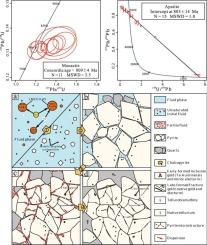北扬子克拉通早新元古代水月思造山带金矿床年代学与黄铁矿地球化学:成矿流体来源与富集过程的指示
IF 3.6
2区 地球科学
Q1 GEOLOGY
引用次数: 0
摘要
与新元古代造山运动有关的金矿床形成在地球历史上是罕见的。早新元古代水月寺金矿床是黄陵金矿田变质基底中产量最高的金矿床,具有金品位高、金- te矿物丰富的特点,为研究新元古代造山作用下的成矿流体来源和金富集过程提供了天然实验室。根据与黄铁矿共生的热液独居石和磷灰石的原位U-Pb定年,精确地将成矿年龄限制在806 Ma左右。成矿前、主、晚、后阶段黄铁矿微量元素组成表明其金含量较低,反映了金成矿作用主要表现为可见金。结合成岩交代岩石圈地幔中广泛存在的Te矿物和同生基性岩脉,不同阶段黄铁矿的原位S同位素(δ34S值为−0.84 ~ 5.24‰)和Pb同位素(206Pb/204Pb、207Pb/204Pb、208Pb/204Pb比值分别为15.53 ~ 16.08、15.16 ~ 15.28和37.05 ~ 37.83)组成反映了与交代交代岩石圈地幔有关的深部流体源。黄铁矿的岩石学观察和微量元素填图表明,黄铁矿中早期形成的Te-Au矿物沉淀和包裹体形式的电子金属液滴与热液中富te低熔点亲铜元素熔体高效提金有关;后期形成的断裂金(天然金和银)从残余流体中析出。该研究有助于进一步认识与新元古代造山运动有关的金成矿成因。本文章由计算机程序翻译,如有差异,请以英文原文为准。

Geochronology and pyrite geochemistry of the early Neoproterozoic Shuiyuesi orogenic gold deposit, northern Yangtze Craton: Implications for ore-forming fluid source and enrichment processes
Gold deposit formation related to the Neoproterozoic orogeny were unusual throughout Earth’s history. As the most productive gold deposit in the metamorphic basement of the Huangling gold field, the Early Neoproterozoic Shuiyuesi deposit is characterized by high Au grade and abundant Au–Te minerals, providing a natural lab to investigate ore-forming fluid source and gold enrichment processes in response to Neoproterozoic orogeny. Based on in-situ U–Pb dating of hydrothermal monazite and apatite in paragenesis with pyrite, this study precisely constrains the mineralization age to ca. 806 Ma. Trace element compositions of pyrite from pre-, main-, late-, and post-ore stages indicate that they have low Au contents, reflecting Au mineralization is predominantly expressed as visible gold. Combined with the widespread occurrence of Te minerals and contemporaneous mafic dikes derived from metasomatized lithospheric mantle, in-situ S isotopic (δ34S values of −0.84 to 5.24 ‰), and Pb isotopic (206Pb/204Pb, 207Pb/204Pb, and 208Pb/204Pb ratios of 15.53–16.08, 15.16–15.28, and 37.05–37.83, respectively) compositions of pyrites from different stages reflect a deep fluid source related to metasomatized lithospheric mantle. Petrographic observations and trace element mapping of pyrite reveal that the precipitation of early-formed Te–Au minerals and electrum metallic droplets as inclusions in pyrites are related to efficient gold extraction by Te-rich LMCE (low-melting point chalcophile elements) melt from hydrothermal fluid; late-formed fracture gold (native gold and electrum) precipitates from the residual fluid. This study promotes a deeper understanding of ore genesis of the Au mineralization related to the Neoproterozoic orogeny.
求助全文
通过发布文献求助,成功后即可免费获取论文全文。
去求助
来源期刊

Ore Geology Reviews
地学-地质学
CiteScore
6.50
自引率
27.30%
发文量
546
审稿时长
22.9 weeks
期刊介绍:
Ore Geology Reviews aims to familiarize all earth scientists with recent advances in a number of interconnected disciplines related to the study of, and search for, ore deposits. The reviews range from brief to longer contributions, but the journal preferentially publishes manuscripts that fill the niche between the commonly shorter journal articles and the comprehensive book coverages, and thus has a special appeal to many authors and readers.
 求助内容:
求助内容: 应助结果提醒方式:
应助结果提醒方式:


